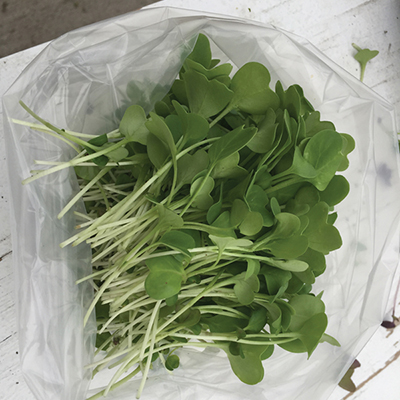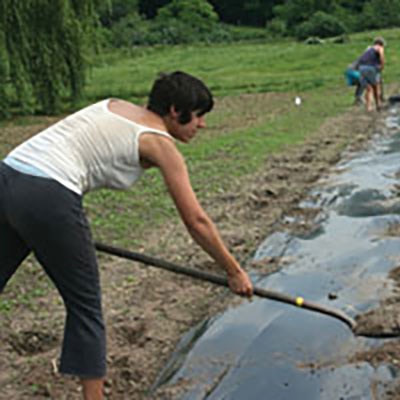Last month I wrote about hot weather cooking greens, and as I said then, cooking greens and salad greens are not two distinctcategories, as many crops can be used both ways. Summer cooking greens which can be used at a young stage for salads include chard, Malabar spinach, Egyptian spinach, vegetable amaranth (especially the varieties All Red and Bliton) and Aztec spinach (Huauzontle). Some of the salad crops in this article can also be grown to full size or adolescent size and used as cooking greens.
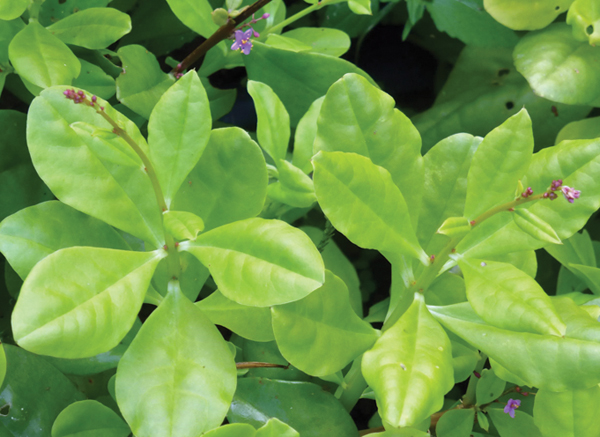
Some salad greens are grown and used alone, some do best as part of a baby salad mix, and others are more of a garnish. Of those used alone, most are Asian greens, particularly Tokyo Bekana and Maruba Santoh, although some people make a salad dish with purslane, dressing, and garnishes.

“Main character”
Tokyo Bekana and Maruba Santoh, both Brassica rapa. These mild-flavored, loose-leaf, non-heading Asian mustards can be harvested after 25 days in the baby leaf stage, or as large leaves after 35 days. They look like chartreuse lettuces. In our central Virginia gardens, we have sown them in June, transplanted a mere two weeks later (they grow so fast!) and used the mature plants as a late summer lettuce substitute. They also taste good lightly cooked (our original plan). They bolt readily in hot weather – the trick is to grow and harvest promptly. They work as hot weather greens by being easy to germinate in hot weather, unlike lettuce. Give plenty ofwater to keep the flavor mild. If cut for baby salad, you may be able to get more than one cut, depending on the weather. Tokyo Bekana is more frilly than Maruba Santoh. Otherwise, in color, flavor, growth rate, and use, they are the same.
Mizu
na Brassica juncea var. japonica or Brassica rapa var. japonica. Mizuna is another mild Japanese mustard, neither hot nor bitter. The ferny leaves and tender stems have a slightly tangy flavor when young, and a mildly peppery flavor when mature. Mizuna is technically a cool-season vegetable, but, like some other Asian greens, it will germinate readily in hot weather. Keep it well watered to grow it fast and harvest it smaller than you would in winter, to get it before it bolts. When it bolts, the flower stalks taste like sweet broccoli with a hint of garlic. Or harvest baby mizuna (about 20 days after sowing) as part of a salad mix.
Garden Purslane (aka duckweed, fatweed, parsley, verdolagas) Portulaca oleracea. This heat-loving, low-growing sprawling weed provides tasty little lemon-flavored succulent leaves for salads, or it can be used as a spinach substitute for cooking. It can also be used to make pesto. If it doesn’t appear spontaneously, sow in late spring. Both the stems and leaves can be eaten, or whole small plants. Pinch the plants back often to prevent reseeding – it became invasive in our garden after we let some go. A single purslane plant can produce up to 200,000 seeds.

Above: The leaves, flowers, and seedheads of Talinum paniculatum, Jewels of Opar. Photos courtesy of Southern Exposure Seed Exchange.
Golden Purslane Portulaca sativa. This yellow cultivated variety of purslane grows upright, as tall as 12”. The leaves are larger than the weed ones, very round and thick. Because of the bright yellow-green color, the plants are visually attractive. The yellow color changes to a deep green as the plant matures. The tiny yellow flowers attract small wasps and other insects early in the morning.
Use for salads or garnish. Don’t try cooking the leaves, or they disintegrate to mush. William Woys Weaver suggests “the young stems, poached in white wine, make a delightful vegetable. They must be harvested young, for when the stems begin to turn pink or red, they will be tough and woody.” He also gives a recipe for pickling purslane. See his book Heirloom Vegetable Gardening, “Saladings, Warm Weather,” where William lists 14 summer salad possibilities, and his blogpost: motherearthnews.com/organic-gardening/heirloom-warm-weather-salad-greens-zewz1309zpit.aspx

Broadcast the seed once the soil is warm enough to plant beans. There is no point planting early, as it will not germinate if the weather is cool. It likes really hot weather, and does well in dry poor soil. Once summer has really arrived and the evenings are hot (over 70°F), sow purslane every two weeks until September. It matures in only 4- 6 weeks, and goes to seed quickly, so if you want a constant supply all summer, you need to make the succession sowings.
Baby salad mix
If you can clear the hurdle of germinating the seeds, many crops can grow to a baby salad size successfully. I learned this from an Atlanta grower at a workshop I was giving aboutsummer crops for hoophouses in the South. I asked the audience what other summer crops they had found success with and he said “arugula.” I thought he must be a traveler from up north, so I asked where he was from and he told me Atlanta, GA. He had the big city markets, and he used his hoophouse as a shaded, weed-free area, and resowed with arugula every week!

Maruba Santoh, above, and Mizuna, left, can be grown fast and harvested young for mild summer salad greens. Photos by Ethan Hirsh.
You might get only a single cutting, as regrowth can be too stemmy and fibrous. The other hurdles are keeping the plants growing fast and staying sweet, and keeping the bugs off (harder in summer). If flea-beetles are a problem, try hoops and ProtekNet insect netting, made by Dubois (1 800 667 6279). For large quantities, buy direct from them. Smaller rolls are available from various suppliers: Purple Mountain Organics in Maryland (www.purpletools.net); Johnny’s Selected Seeds (www.johnnyseeds.com) stocks “Biothrips” insect netting (the smallest mesh). Choose the smaller of the five or more mesh sizes to keep out flea beetles – the larger sizes work well for cucumber beetles, harlequin bugs and other medium or large insects. The Dubois website includes tables of descriptions of the various grades (17gm, 25gm, 52gm, 60gm, 70gm, 80gm). Read their brochure to figure out what you need. My reading suggests the 25gm 0.0138 x 0.0138” mesh or the 52gm 0.0098 x 0.0287” mesh will work. The heavier weight could last five years, compared to one to three years for the lighter one. Some growers are also using insect netting in place of plastic over their high tunnel (hoophouse) frames in summer.
I found a great discussion (spanning 15 years!) from Everett in Utah: http://forums.gardenweb.com/discussions/2021697/hot-weather-greens
He grew a salad mix of baby collards, baby chard (bright lights), baby kale (red Russian), and beet greens (Red Ace) in his very hot summer climate, (100°F in the Utah desert in July). He moved on to add vitamin green and komatsuna, Bull’s Blood beet greens, Tokyo bekana, cutting celery and tetragonia (New Zealand spinach). This salad mix was in the open, without shade cloth.
His growing technique at one stage involved growing the greens in a 3” layer of 100% mushroom compost on top of hay bales. He harvested twice a week getting 48# from 6 “tables” 35-40’ long, in about 4-5 hours. After 3 seasons of hay bale tables, he went back to growing in the ground, because the bales rotted too fast, and the expense of rebuilding didn’t pay. In the field, he plants the greens in single rows about 4” apart. He found that denser spacing (broadcast) made the greens choke each other out and was conducive to diseases.
Komatsuna Brassica rapa var. perviridis or Brassica rapa L. Nothovar. Garden Betty, in Summer-Lovin’ Salad Greens http://www.gardenbetty.com/2012/06/summer-lovin-salad-greens/ finds this Asian leaf vegetable does equally well in the warmer days of summer in southern California as it does in winter. It can be used in baby salad mixes. In climates similar to southern California you can grow it to maturity in a few weeks and it will produce leaves for months.
Yukina Savoy Brassica juncea. This Asian green looks like a big tatsoi but with dark green savoyed leaves. It tolerates growing conditions from warm to cold, and lasts all summer long in southern Florida, and anything less intense. The young leaves (stems and all) are delicious raw, and the mature plants cooked.
Jewels of Opar (aka Fame flower) Talinum paniculatum. I learned about this jewel from Southern Exposure Seed Exchange. It is a purslane relative that thrives in hot weather. The small mild-tasting leaves – up to about 4 inches long – are succulent, light green, and eye-catching. The 2-3’ tall plants can reach 3’ wide. It grows in full sun or partial shade, and will tolerate poor soil.
It self-sows readily and may naturalize (this can be taken as a coded warning not to let it seed where you don’t want it forever!). At SESE in central Virginia, self-sown seedlings came up by early fall. Extra seedlings are easy to pull up, and the seedlings that you decide to keep can be a great addition to your work-day snacks. This plant is native to parts of the South and the Caribbean, and is perennial in zones 8 and up.
See http://www.southernexposure.com/blog. Irena Hollowell describes sowing the seed in spring, spotting the seedlings into flats, and transplanting. She tasted a few of the baby leaves while transplanting, and “found the succulent greens surprisingly appealing.” Her surprise was to find greens that grow well in the height of summer and “have an appealing taste and texture for eating raw in significant quantities”. Many succulents such as Malabar spinach have a slippery texture. Jewels of Opar, like purslane, is a bit mucilaginous, but not as much as Malabar spinach or okra.
The plants quickly start to flower (before they exceed 2” wide) sending up thin stems with elegant panicles of 3⁄8” pink flowers. There is no need to worry that you did something wrong and your crop is over. Unlike arugula, mustards, kales, and other brassicas whose leaves and stems become tougher, spicier, and less marketable when they bolt, the leaves of Jewels of Opar remain mild and tender. You can, if you like, cut the plants back and they will send up tender new shoots, or you can keep the flowers and harvest the leaves below them. The leaves are great in salads, in sandwiches, and cooked as a spinach substitute. Jewels of Opar also has medicinal uses, although I am not qualified to speak on that topic.
From early summer until frost, Jewels of Opar plants send up many heads of the tiny pink flowers (even without deadheading). Your second crop (floral) has just begun. The light hazy flowers can be used for decoration. A pretty addition in a southern garden or market booth in July! This useful green leafy vegetable is better known to flower gardeners than to vegetable farmers. The flowers attract bees and other pollinating insects.
Later the seedstalks can feature in fresh and dried arrangements. The seedpods change color from orange, through red, brown, gold, and grey as they dry down. Even after they are blackened by frost, the seed stalks could make a dramatic framework for dried flower arrangements.
Salad garnishes
Many herbs and other plants you may already have growing, can be used as salad garnishes. Examples include nasturtium leaves, small nutty-flavored buckwheat leaves, leaves of roselle, anise-hyssop, cilantro, dill and basil. Some plants can be grown in flats closely spaced, and cut for garnishes: 4-6” sunflower shoots, 3” popcorn or other corn shoots.
Parà Cress aka Spilanthes Cress, Spilanthes oleracea. This sprawling South American vine has a flavor resembling pennyroyal. The leaves may be used as a salad garnish, although not eaten in quantity, because they cause a slight numbing sensation in the mouth. Sow indoors and plant out in a hot dry location after all danger of frost is past. Protect the small seedlings from slugs.
Red Shiso, aka Black Nettle, Perilla frutescens. A type of perilla which thrives in shade or sun, growing to 18” tall. All parts of the plant are edible, including the flowers. The leaves can also be dried and used for tea. It germinates quickly in hot weather, flowers late in summer, and reseeds readily.
Saltwort, Batis maritime is native to coastal areas of southern United States. It tolerates salt and flooding but not shade. Seed is readily available. It grows as a low shrub with succulent leaves which keep their form when cooked. The shoot tips may be used for salads. It can easily be propagated by cuttings.
Microgreens can be a quick way to add garnishes to salads, or they can be sold by the tray to restaurants. They are young seedlings densely grown in flats until about 2” tall, then clipped. Generally they have only seed leaves at harvest stage. Many kinds of seed can be used, such as mustards, cresses, radishes. Because a lot of seed will be used, the cost of seed is a factor to consider. Because they can be grown indoors (with good lights), this crop is fairly independent of the weather.
Pam Dawling manages 3.5 acres of vegetable gardens at Twin Oaks Community in central Virginia. Her book, Sustainable Market Farming: Intensive Vegetable Production on a Few Acres, is widely available, including at www.sustainablemarketfarming.com, or by mail order from Sustainable Market Farming, 138 Twin Oaks Road, Louisa, Virginia 23093. Enclose a check (payable to Twin Oaks) for $40.45 including shipping. Pam’s blog is on her website and also on facebook.com/SustainableMarketFarming


 To get right to the point, one of my goals as a farmer, and as a person who wants to do something useful with her life, is to make the local, sustainably produced food that we all sell normal. By that, I mean available where the vast majority of Americans shop: grocery stores. As I see it, polished, professional products and service that sells itself is the most direct way to that goal.
To get right to the point, one of my goals as a farmer, and as a person who wants to do something useful with her life, is to make the local, sustainably produced food that we all sell normal. By that, I mean available where the vast majority of Americans shop: grocery stores. As I see it, polished, professional products and service that sells itself is the most direct way to that goal. 
 Plan now for a crop from stored roots next winter
Plan now for a crop from stored roots next winter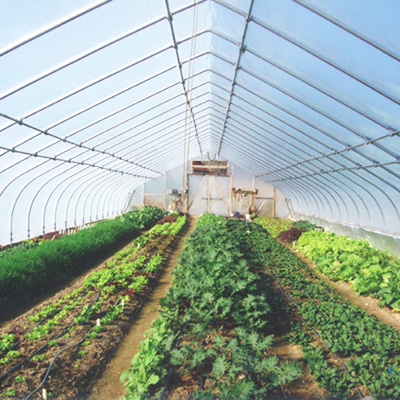





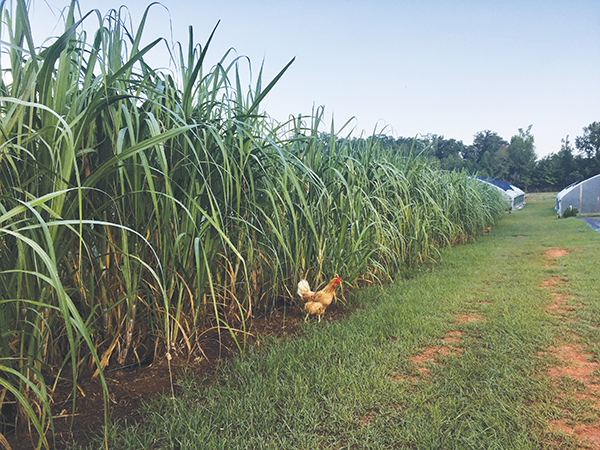 Julia Asherman appeared on my radar screen a number of years ago because she was a regular presence at the Southern Sustainable Agriculture Working Group conferences where I’ve spoken many times. Colleagues pointed her out to me as a person to watch because she was tough and smart and she was going to make something of herself as a farmer. We became conference buddies. So, when I had the good fortune to get invited to speak at the Georgia Organics Conference in Athens this winter, I knew right away I wanted to take that opportunity to visit Julia at her place, Rag & Frass Farm in Jeffersonville, Georgia.
Julia Asherman appeared on my radar screen a number of years ago because she was a regular presence at the Southern Sustainable Agriculture Working Group conferences where I’ve spoken many times. Colleagues pointed her out to me as a person to watch because she was tough and smart and she was going to make something of herself as a farmer. We became conference buddies. So, when I had the good fortune to get invited to speak at the Georgia Organics Conference in Athens this winter, I knew right away I wanted to take that opportunity to visit Julia at her place, Rag & Frass Farm in Jeffersonville, Georgia.